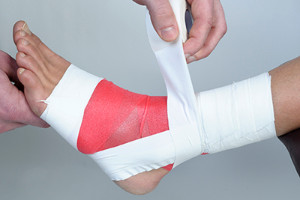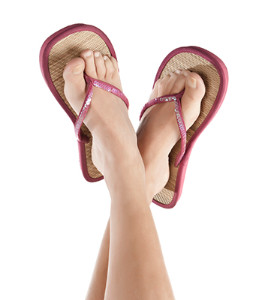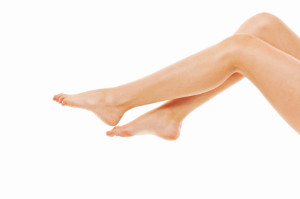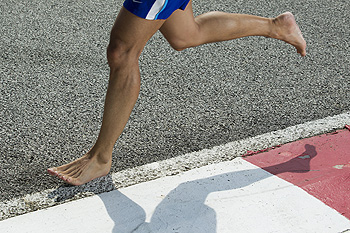Items filtered by date: June 2017
Cleveland Browns Top Pick Suffers Sprained Foot
 The Cleveland Browns recently learned that their top pick, Myles Garrett, suffered a sprain in his left foot. Garrett suffered the injury during the late stages of a practice and was seen grabbing his foot in pain immediately afterward. He is currently in a walking boot and is expected to receive treatment before the Browns training camp opens in late July. Although Garrett played most of last season with a severely sprained left ankle, the team was very impressed with him during spring workouts. According to the team’s defensive coordinator, “It is still way early, but you guys are going to see a pretty good football player when he gets the chance to get out there and go.”
The Cleveland Browns recently learned that their top pick, Myles Garrett, suffered a sprain in his left foot. Garrett suffered the injury during the late stages of a practice and was seen grabbing his foot in pain immediately afterward. He is currently in a walking boot and is expected to receive treatment before the Browns training camp opens in late July. Although Garrett played most of last season with a severely sprained left ankle, the team was very impressed with him during spring workouts. According to the team’s defensive coordinator, “It is still way early, but you guys are going to see a pretty good football player when he gets the chance to get out there and go.”
Sports related foot and ankle injuries require proper treatment before players can go back to their regular routines. For more information, contact one of our podiatrists of Sayville Foot Care. Our doctors can provide the care you need to keep you pain-free and on your feet.
Sports Related Foot and Ankle Injuries
Foot and ankle injuries are a common occurrence when it comes to athletes of any sport. While many athletes dismiss the initial aches and pains, the truth is that ignoring potential foot and ankle injuries can lead to serious problems. As athletes continue to place pressure and strain the area further, a mild injury can turn into something as serious as a rupture and may lead to a permanent disability. There are many factors that contribute to sports related foot and ankle injuries, which include failure to warm up properly, not providing support or wearing bad footwear. Common injuries and conditions athletes face, including:
- Plantar Fasciitis
- Plantar Fasciosis
- Achilles Tendinitis
- Achilles Tendon Rupture
- Ankle Sprains
Sports related injuries are commonly treated using the RICE method. This includes rest, applying ice to the injured area, compression and elevating the ankle. More serious sprains and injuries may require surgery, which could include arthroscopic and reconstructive surgery. Rehabilitation and therapy may also be required in order to get any recovering athlete to become fully functional again. Any unusual aches and pains an athlete sustains must be evaluated by a licensed, reputable medical professional.
If you have any questions please feel free to contact our office located in Sayville, NY . We offer the newest diagnostic and treatment technologies for all your foot and ankle needs.
How Wearing Flip-Flops May Cause Plantar Fasciitis
 Plantar fasciitis is a common condition that tends to appear during the summer months, and flip-flops could be one of the reasons this happens. Flip-flops offer no support for the feet, which causes the plantar fascia to stretch unnaturally; this may lead to heel pain. Wearing flip-flops also causes you to scrunch your toes in order to grip the thong of the sandal, causing you to shorten your stride. As a result, you may experience hammertoes, muscle pain, and shin splits from forcing your legs to work harder.
Plantar fasciitis is a common condition that tends to appear during the summer months, and flip-flops could be one of the reasons this happens. Flip-flops offer no support for the feet, which causes the plantar fascia to stretch unnaturally; this may lead to heel pain. Wearing flip-flops also causes you to scrunch your toes in order to grip the thong of the sandal, causing you to shorten your stride. As a result, you may experience hammertoes, muscle pain, and shin splits from forcing your legs to work harder.
Flip-flops are not always the best choice of footwear. If you have any concerns about your feet or ankles, contact one of our podiatrists from Sayville Foot Care. Our doctors will assist you with all of your foot and ankle needs.
Flip-Flops and Feet
When the weather starts warming up, people enjoy wearing flip-flops. Flip-flops are comfortable, stylish, and easy to slip on and off; they're perfect for any summer beach goer. However, these shoes can cause harm to the feet.
How Can Flip-Flops Affect Me Long-Term?
- Ankle problems
- Hip problems
- Lower back problems
- Pain in the balls of the feet
- Problems with foot arches
- Changes in the way you walk
Are There Injuries Associated with Flip-Flops?
Yes. Since flip-flops are relatively weak and do not provide the same amount of support as sneakers, people who wear flip-flops regularly are more susceptible to injuries. On top of that, the open nature of the shoe makes your feet more prone to other problems, such as cuts and even infections. Common injuries and ailments include:
- Sprained ankles
- Blisters
- Infections
- Cuts and Scrapes
I like Wearing Flip-Flops. Are There Safe Alternatives?
When buying flip-flops, try to find ones that have sturdy soles and that are made of high-quality materials that will support for your feet. These flip-flops will cost more but will also last longer as a result.
If you have any questions please feel free to contact our office located in Sayville, NY . We offer the newest diagnostic and treatment technologies for all your foot and ankle needs.
Preventing Ingrown Toenails
 An ingrown toenail is something that may be preventable by taking the right steps. One of the most important precautions you can take to avoid getting an ingrown toenail is to make sure your shoes fit properly. Your shoes should have space in the front so that your toes have room to move around. Your toes should be able to “rest flat and straight” inside of your shoe. Another way to prevent ingrown toenails is to cut your toenails straight across instead of in a rounded shape. Cutting them straight across will allow your nails to grow out correctly, instead of growing down into your toe. Although there are ways you can prevent ingrown toenails, you should always see a podiatrist if you see any signs of infection.
An ingrown toenail is something that may be preventable by taking the right steps. One of the most important precautions you can take to avoid getting an ingrown toenail is to make sure your shoes fit properly. Your shoes should have space in the front so that your toes have room to move around. Your toes should be able to “rest flat and straight” inside of your shoe. Another way to prevent ingrown toenails is to cut your toenails straight across instead of in a rounded shape. Cutting them straight across will allow your nails to grow out correctly, instead of growing down into your toe. Although there are ways you can prevent ingrown toenails, you should always see a podiatrist if you see any signs of infection.
Ingrown toenails can become painful if they are not treated properly. For more information about ingrown toenails, contact one of our podiatrists of Sayville Foot Care. Our doctors can provide the care you need to keep you pain-free and on your feet.
Ingrown Toenails
Ingrown toenails occur when a toenail grows sideways into the bed of the nail, causing pain, swelling, and possibly infection.
Causes
- Bacterial infections
- Improper nail cutting such as cutting it too short or not straight across
- Trauma to the toe, such as stubbing, which causes the nail to grow back irregularly
- Ill-fitting shoes that bunch the toes too close together
- Genetic predisposition
Prevention
Because ingrown toenails are not something found outside of shoe-wearing cultures, going barefoot as often as possible will decrease the likeliness of developing ingrown toenails. Wearing proper fitting shoes and using proper cutting techniques will also help decrease your risk of developing ingrown toenails.
Treatment
Ingrown toenails are a very treatable foot condition. In minor cases, soaking the affected area in salt or antibacterial soaps will not only help with the ingrown nail itself, but also help prevent any infections from occurring. In more severe cases, surgery is an option. In either case, speaking to your podiatrist about this condition will help you get a better understanding of specific treatment options that are right for you.
If you have any questions please feel free to contact our office located in Sayville, NY . We offer the newest diagnostic and treatment technologies for all your foot and ankle needs.
The Effects of Barefoot Running
 There are a lot of debates about whether or not barefoot running is beneficial for the feet. Although research suggests that there are several benefits from running barefoot, there are also plenty of risks. Running without shoes is proven to be hazardous due to dangerous debris or sharp rocks that may be on the ground. In order to prevent some of these issues, barefoot shoes were created. These shoes are able to simulate the feeling of running barefoot while reducing the dangers that may result from it.
There are a lot of debates about whether or not barefoot running is beneficial for the feet. Although research suggests that there are several benefits from running barefoot, there are also plenty of risks. Running without shoes is proven to be hazardous due to dangerous debris or sharp rocks that may be on the ground. In order to prevent some of these issues, barefoot shoes were created. These shoes are able to simulate the feeling of running barefoot while reducing the dangers that may result from it.
Barefoot running has its own share of benefits and disadvantages. If you have any concerns about your feet or ankles, contact one of our podiatrists from Sayville Foot Care. Our doctors will treat your foot and ankle needs.
Barefoot Running
The Impact of Barefoot Running
- Running without shoes changes the motion of your running, as most running is done by landing on the heel of the feet.
- Running barefoot requires a different way of running; the landing is done on the front part of the feet.
The Advantages of Barefoot Running
- When running and landing on the front feet, the impact on the feet and ankle is reduced; this can reduce stress injuries.
- It strengthens muscles in the feet, ankles and lower legs.
- Balance of the body is improved, and there is a greater sensory input from the feet to the rest of the body.
The Drawbacks of Barefoot Running
- No protection while running, makes it likely that runners will land on sharp objects and scrapes, bruises and cuts on the feet will result.
- Blisters may form.
- Possibility of plantar fascia problems.
- Risk of getting Achilles tendonitis.
So, what can runners do to make barefoot running safe? It’s best to make a slow transition from running shoes to barefoot running. Once the feet begin to adjust, try walking, then jogging and gradually increasing the distance. Minimalist running shoes may also be an option.
If you have any questions please feel free to contact one of our office located in Sayville, NY . We offer the newest diagnostic and treatment technologies for all your foot and ankle needs.
